Nutritionist’s Take on the Fasting Mimicking Diet
Written By: Jeremy Fox, CNC, CPT – Published: January 16, 2024

I’ve spent the last 15 years researching and experimenting with nutrition to reach health and fitness goals. As a Nutrition Coach, I typically avoid fad diets and meal kits that promote “too good to be true” benefits.
However, fasting is a dietary strategy that’s been around for thousands of years with many proven benefits. So, when I started reading about a fasting-mimicking diet, I was immediately interested, and I decided to try it for myself to see if it was worth recommending to you and my clients.
In this article, I explain the fasting-mimicking diet and how it works. I shed light on the studies to reveal if it’s based on science or speculation. And I share my experience with a 5-day fasting-mimicking diet plan.
What Is the Fasting Mimicking Diet
The fasting-mimicking diet (FMD) is a short-term nutrition plan low in calories, sugars, and protein but high in healthy fats. This type of nutritional intervention has been shown to have beneficial effects on risk factors associated with obesity and age-related diseases.
FMD is based on research by Dr. Valter Longo of the University of Southern California. He developed Prolon, a 5-day nutrition program that does not trigger the various food-sensing pathways, providing the benefits of fasting while nourishing the body with essential nutrients.
Also, unlike other diets requiring long-term lifestyle changes, fasting-mimicking is only meant to be used for a very short period.
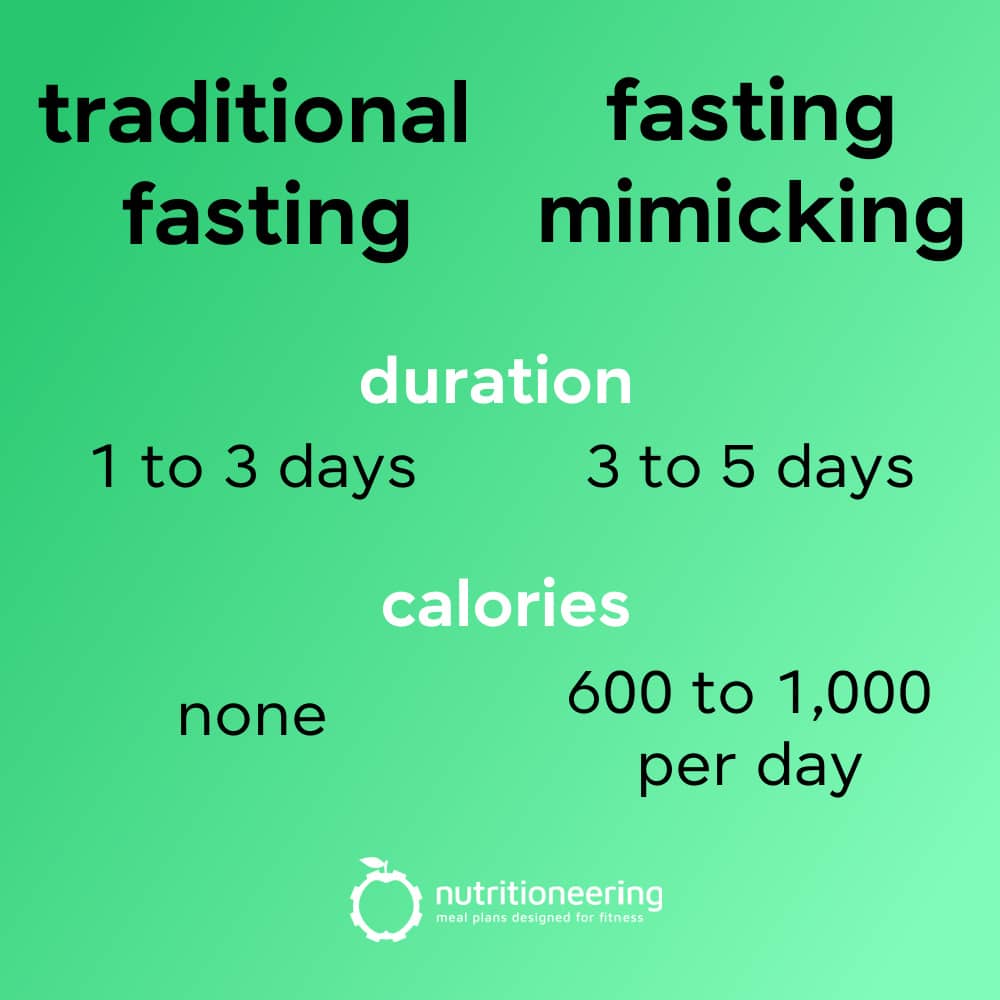
How Does It Work?
The fasting-mimicking diet is a very low-calorie eating plan designed to simulate the effects of fasting on the body. Controlled calorie restriction on the FMD diet reduces serum glucose and insulin-like growth factor (IGF-1), which have a role in pathways that signal aging and cancer1.
It’s theorized that high-glycemic carbs and animal proteins interfere with the protective and regenerative effects of fasting. Therefore, the FMD diet consists of low-glycemic plant-based foods and a reduced protein intake to promote healthy aging and increase longevity.
Traditional fasting or intermittent fasting diets can be challenging to adhere to and have possible adverse effects that restrict their practical use. On the other hand, short FMD cycles are considered relatively safe and effective in diminishing markers and risk factors associated with aging and age-related ailments1.
Science Behind FMD
I reviewed clinical studies published in medical journals to determine if the fasting-mimicking diet is based on an acceptable level of evidence. There have been dozens of animal studies2,3,4 (using mice) and some in vitro human studies5 (in a test tube), but I only found two clinical trials conducted with actual humans1,6.
In a 2017 study, researchers performed a randomized control trial with 71 people divided into two groups in a crossover design. The participants followed either an unrestricted diet for three months or one 5-day fasting-mimicking diet cycle each month for three months.
About one week after the third FMD cycle was completed, researchers measured changes in markers associated with chronic disease. The FMD group had reduced body weight, BMI, body fat, waist circumference, systolic blood pressure, and IGF-1 compared to the control group.
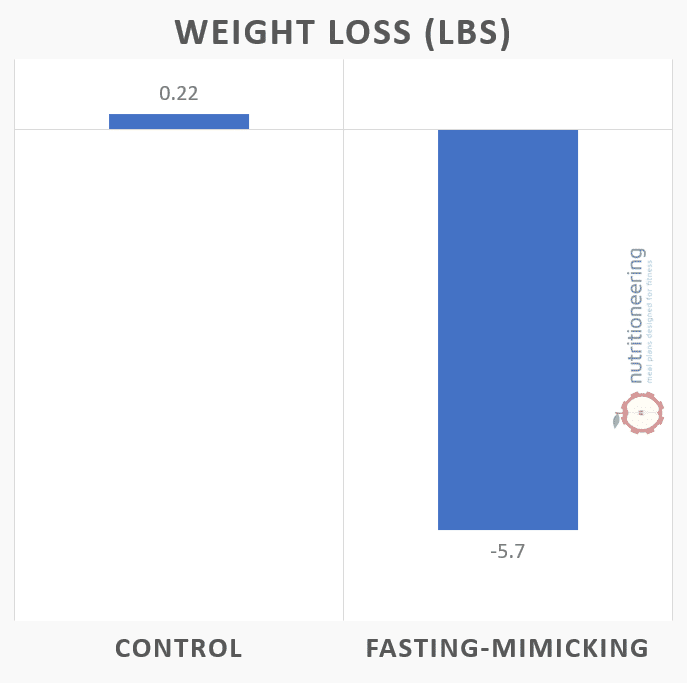
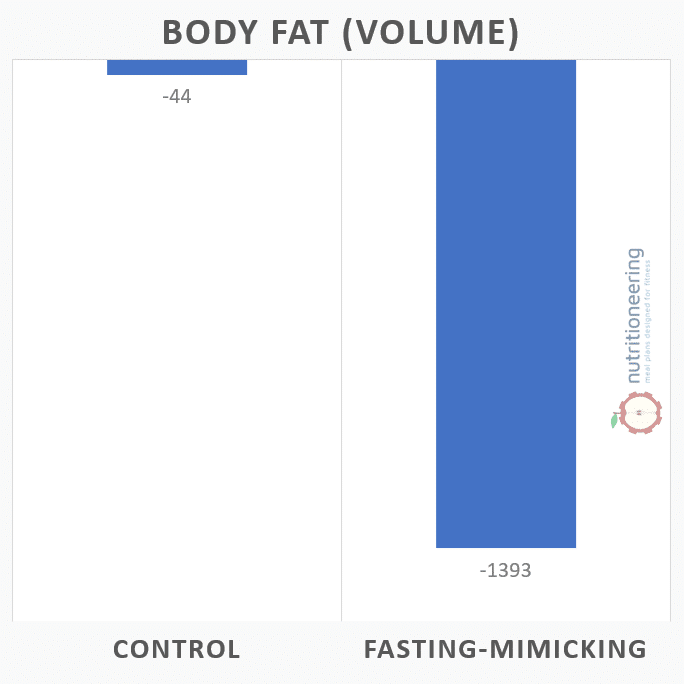
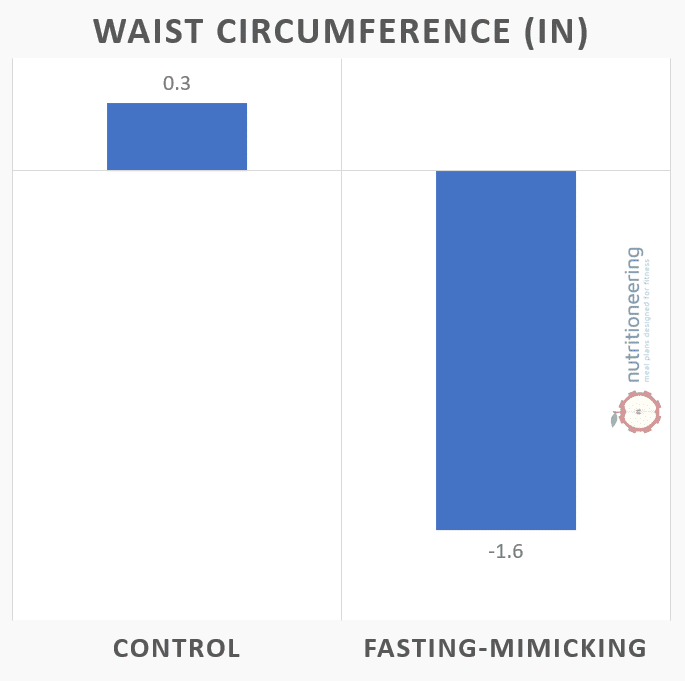
However, metabolic markers such as fasting glucose, triglycerides, C-reactive protein, HDL, LDL, and total cholesterol were not significantly affected after three FMD cycles. A follow-up showed that the effects of the FMD persisted three months after study completion, although changes in dietary habits or physical activity could have influenced those results.
The findings of this study are very encouraging, but there are limitations to be aware of. First, the study design used a monthly 5-day fasting protocol, the highest recommended frequency.
Also, the study was funded by L-Nutra Inc. (the company that owns Prolon), and Dr. Longo was one of the authors. So, there are competing interests to demonstrate favorable results and sell more of their diet product. That bias doesn’t necessarily mean the study was flawed, but it should be considered.
Prolon 5-Day Fasting Mimicking Diet
Prolon nutrition programs consist of various fasting bars, shakes, and pre-assembled kits to implement in your diet. The most popular product is a five-day plan that includes all the foods and drinks you need to complete the fasting-mimicking diet at home.
The 5-day fasting mimicking kit from Prolon includes soups, nut bars, snacks, herbal teas, drink mixes, and supplements. It also comes with a meal plan showing you exactly what to eat each day of the fasting-mimicking diet.
Here’s what the 5-day FMD meal plan looks like.

Each box in the Prolon fasting-mimicking diet kit contains everything you should eat for that day. The kit also comes with fasting shakes, soup substitutes, and the Longevity Diet book.
Table 1. Prolon Fasting Mimicking Meal Plan
| Day 1 | Day 2 | Day 3 | Day 4 | Day 5 | |
|---|---|---|---|---|---|
| Breakfast | Nut Bar Herbal Tea Algal Oil |
Nut Bar Herbal Tea |
Nut Bar Herbal Tea |
Nut Bar Herbal Tea |
Nut Bar Herbal Tea Algal Oil |
| Lunch | Carrot Ginger Soup Crackers Olives Multivitamin |
Green Pea & Chives Soup Multivitamin |
Chickpea & Leeks Soup Crackers Multivitamin |
Carrot Ginger Soup Olives Multivitamin |
Red Bell Pepper & Onion Soup Crackers Multivitamin |
| Snack | Nut Bar Herbal Tea |
Olives Herbal Tea |
Herbal Tea | Olives Herbal Tea |
Herbal Tea |
| Dinner | Red Bell Pepper & Onion Soup Choco Crisp Bar |
Lentil Curry Soup Choco Crisp Bar |
Red Bell Pepper & Onion Soup | Green Pea & Chives Soup Choco Crisp Bar |
Lentil Curry Soup |
| All Day | Glycerol Drink Mix | Glycerol Drink Mix | Glycerol Drink Mix | Glycerol Drink Mix |
My Experience With the Fasting Mimicking Diet
As part of my New Year’s health kick, I purchased the Prolon 5-day program. After a couple of months of overeating and indulging in holiday treats, my goal was to shed some pounds while resetting my insulin sensitivity.
This diet marked the first time I went without animal protein and followed a plant-based diet for more than one day. Also, it represented one of the most significant cumulative energy deficits I’ve put my body into.
While I’ve used intermittent fasting before and completed multiple 24-hour fasts, I was a bit nervous about restricting calories for an extended duration. My primary concerns were hunger, losing lean mass, and not seeing the claimed benefits.
So, I decided to treat this like a case study and keep meticulous notes about dietary intake along with several physical measurements throughout the FMD. The table below shows the actual calories and macros each day of the FMD plan.
Table 2. 5-Day Fasting Mimicking Diet Calories & Macros
| Day 1 | Day 2 | Day 3 | Day 4 | Day 5 | |
|---|---|---|---|---|---|
| Protein | 23g | 20g | 16g | 15g | 15g |
| Carbs | 97g | 100g | 81g | 82g | 82g |
| Fat | 65g | 51g | 36g | 36g | 37g |
| Calories | 1,065 | 939 | 712 | 712 | 721 |
Blood Sugar and Ketone Bodies
I used a glucose monitor to check fasting blood sugar and ketone bodies each morning. For the first couple of days, my blood sugar crept up, possibly due to glycogen stores being turned into glucose. By day three, it dropped as I entered fasting mode, although it stayed within the normal range (70-100 mg/dL).
Initially, I was skeptical about being able to reach ketosis with the FMD diet due to the higher carb and lower fat intake compared to the ketogenic diet. However, I was surprised to reach nutritional ketosis (>0.5 mg/dL) by day three and optimal ketosis (>1 mg/dL) by day 5.
In my case, it appears that the fasting state of FMD is effective in lowering blood sugar and promoting fat burning, similar to the keto diet.
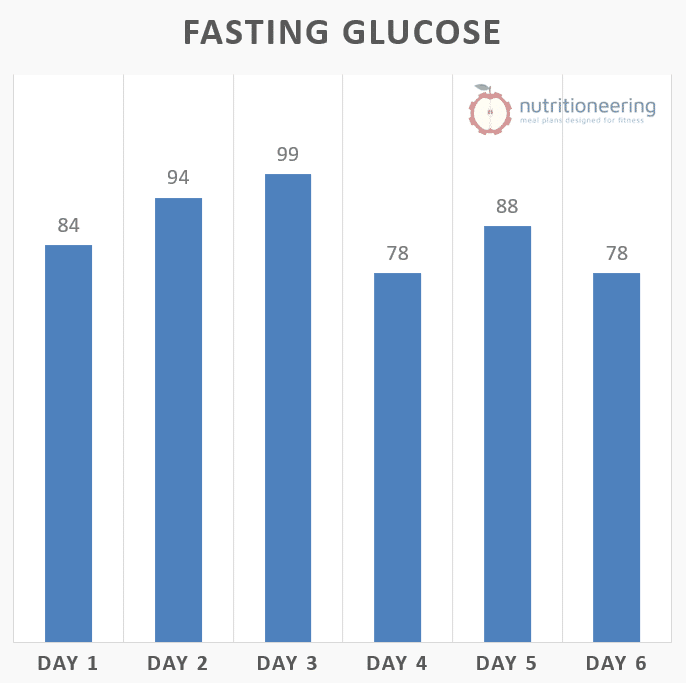
My actual fasting blood glucose measurements show that I was in the healthy range when I started the FMD. It appears that my levels may have dropped during the diet, which is a sign of improved insulin function.
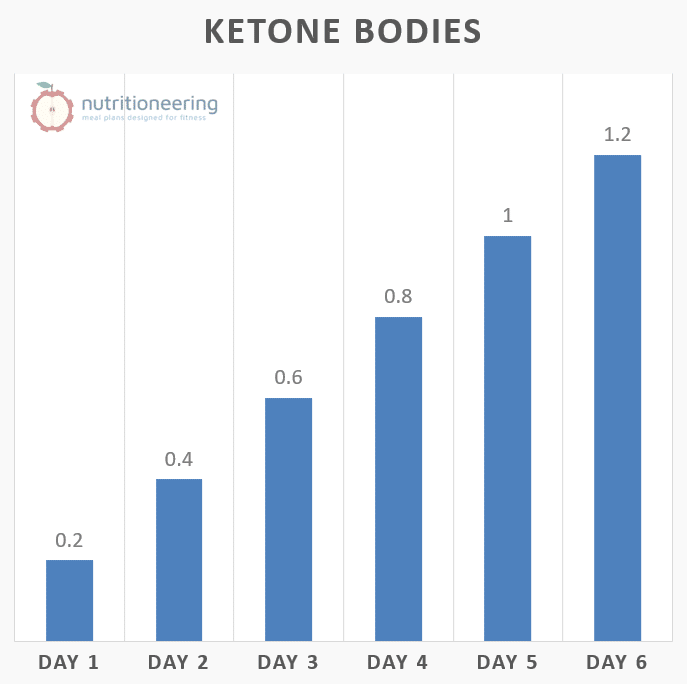
Ketone bodies incrementally increased each day, which is a sign of fat burning. This is either a very linear process or a lack of discrimination by the measurement system.
Hunger, Energy, and Recovery
Based on my experience with periodic fasting, I expected to be famished after a few days on the FM diet. However, I was pleasantly surprised by how satiated I felt after the small meals, particularly the hot soups. Don’t get me wrong, I was pretty hungry, but it wasn’t enough to make me waiver from the diet.
The hardest part was probably grocery shopping, meal prepping for after the diet, and watching my wife eat. She would frequently forget I was on the diet and offer me bites of her food, but her moral support made sticking to the diet much easier.
A few times, my energy levels plummeted, and I felt lethargic. However, my wife noticed that I seemed calmer throughout the diet. Overall, my energy levels were good, especially considering I completely removed caffeine.
The table below shows sleep and recovery metrics measured by my Oura ring.
Table 3. Fasting Mimicking Diet Recovery Metrics
| Baseline | Fasting Mimicking | |
|---|---|---|
| Resting Heart Rate | 56 bpm | 49 bpm |
| Deep Sleep | 1h 23m | 1h 46m |
| Daily Restorative Time | 2h 19m | 4h 17m |
As you can see in Table 3, my nighttime resting heart rate averaged below 50 beats per minute while on the fasting-mimicking diet. This is significantly lower than my baseline of 56 bpm, likely due to not eating large meals close to bedtime.
Additionally, I averaged 23 more minutes of deep sleep each night, the sleep stage associated with physical recovery. I also fell asleep about 30% faster, although my REM sleep was not significantly different.
Finally, my daily restorative time nearly doubled, indicating I spent more time in a relaxed and recovered state. This is partially because I wasn’t stressing my body with resistance training workouts.
Weight Loss and Fat Loss
In total, I lost 8 pounds during the 5-day fasting-mimicking diet. This was mostly in the first two days, which indicates glycogen and water depletion.
To illustrate, the average person stores about one pound of glycogen in their muscles and liver. Additionally, each pound of glycogen holds another 3-4 pounds of water, which accounts for the first 4-5 pounds of weight lost while fasting or following low-carb diets.
I also took skin fold caliper measurements, and my body fat percentage decreased from roughly 13% to about 12%, corresponding to 2.4 pounds of fat loss. The cumulative caloric deficit during the FMD was around 7,500, which makes the amount of fat loss reasonable (7,500 calories / 3,500 calories per lb of fat = 2.2 lbs of fat).
The mirror also corroborated these measurements as I lost inches off my waist and gained abdominal definition. However, my muscles appeared depleted and flat.
Table 4. Fasting Mimicking Diet Weight Loss
| Day 1 | Day 2 | Day 3 | Day 4 | Day 5 | Day 6 | |
|---|---|---|---|---|---|---|
| Body Weight (lbs) | 176.7 | 173.9 | 172.4 | 170.4 | 169.7 | 168.7 |
| Percent Body Fat | 13% | 12% |
Would I Do It Again?
The Prolon fasting mimicking program was a great experience and opened my eyes to the benefits of very low-calorie diet cycles. That said, there were some parts of the program that I didn’t like.
First, I am not a big fan of olives, and there were several meals in which you had to eat about ten raw olives. I would have rather taken a shot of olive oil! Also, the powder-based soups are chunky and gritty, no matter how well you mix them with water.
Second, the Prolon program doesn’t seem to be designed to fit individual needs regarding food preferences and dietary goals. The kit came with several extra tea packets and soup substitutes, so it seems like people have complained about the taste and lack of options.
I could see situations where I would use the fasting-mimicking diet in the future for both myself and my nutrition clients. However, I will probably develop a DIY diet to save money and better suit my tastes.
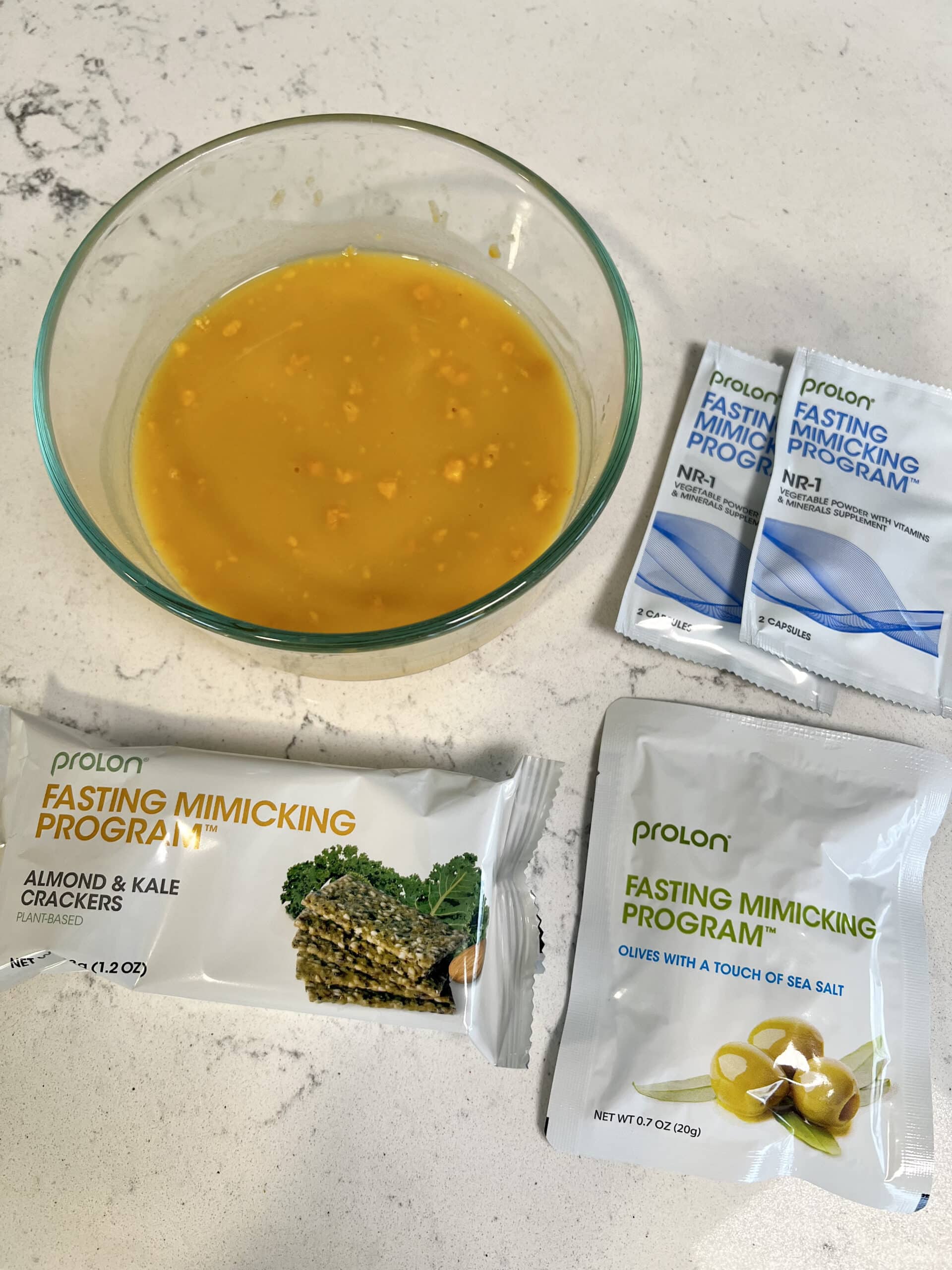
No matter how I mixed, shook, or stirred the powder and water, the ProLon soup always had chunks in it. Maybe a whisk or power mixer would work better.
DIY Fasting Mimicking Diet
The Prolon fasting-mimicking kit suggests that it contains proprietary ingredients designed to increase autophagy and enhance the longevity effects of the diet. Furthermore, the instructions specifically say that attempting to substitute foods will diminish the effectiveness of the diet.
While that may be true, I believe it’s mostly an attempt to keep people buying the diet kits from Prolon. Most of the FMD’s benefits come from reduced caloric intake, plant foods, and decreased protein intake. Therefore, a homemade fasting-mimicking diet plan could potentially achieve the same results.
When creating your own fasting-mimicking plan, here are some things to keep in mind:
- Target 1,000-1,100 cals on days 1-2, and 700-800 cals on days 3-5
- Each meal should be under 300 calories
- Use only plant-based ingredients
- Limit protein to less than 30 grams daily
- Limit carbs to less than 100 grams daily
- Include healthy unsaturated fats
Fasting Mimicking Diet FAQ
Hopefully, the information above has provided valuable insights into the fasting-mimicking diet. But if you still have questions, look through the list of common queries below.
How often should I use the fasting mimicking diet?
Clinical trials studied the fasting-mimicking diet for five consecutive days once per month for three months. However, Dr. Valter Longo, director of the Longevity Institute at USC, recommends the following:
- Every month for 3 or 4 months for therapeutic effects, then once every three months to maintain the benefits.
- 3 times per year for healthy aging and weight loss (once every four months).
- 2 times only per year for general health and longevity purposes (once every six months).
What are the side effects of the fasting mimicking diet?
In a 2017 clinical trial, the most common self-reported symptoms experienced by fasting-mimicking dieters were fatigue, weakness, and headaches. After three cycles, no adverse effects were reported, and blood panels showed no negative effects on liver or kidney function.
Remember, individual health concerns could result in different side effects while fasting. It’s always a good idea to consult with your healthcare provider and perform periods of fasting under medical supervision to avoid adverse effects.
How much weight should I expect to lose?
Everybody is different, and the amount of weight you lose depends on several factors, such as starting weight, body composition, and previous diet habits. That said, clinical trial participants who completed three rounds of FMD averaged 5.7 pounds of weight loss, ranging from 0.2 to 11.2 pounds.
What can I drink on the fasting mimicking diet?
The Prolon diet comes with a proprietary fruit-flavored glycerol mix that you combine with about a liter of water and drink throughout the day. You can also drink low-calorie tea or black coffee in small amounts. But drinks with added ingredients or calories are not ideal during fasting.
Should I exercise during the fasting mimicking diet?
Low-intensity exercise, like a slow walk, is fine while following the fasting-mimicking plan. However, it would be best to avoid high-intensity exercise as it can trigger specific metabolic pathways similar to eating. Therefore, relaxing and letting your body recover during the FMD period is best.
Is keto a fasting mimicking diet?
Ketogenic diets reduce blood sugar and insulin while increasing ketone bodies, similar to the fasting mimicking diet. However, keto diets involve high protein and fat intakes, which trigger mTor and other metabolic pathways. Therefore, they do not provide the same rejuvenation effects associated with fasting or FMD protocols.
Custom Meal Plan
Get a personalized meal plan designed specifically for your body and lifestyle. Including custom recipes formulated to fit your macros and calories – no counting required!
All this for just $13.99/mo! Click here to choose your plan.
Final Thoughts
A growing body of research surrounds fasting-mimicking and suggests this diet may provide many health benefits related to cardiovascular disease, autoimmune diseases, cancer, Alzheimer’s disease, and more. However, more research is needed to solidify these effects in humans.
Nevertheless, fasting-mimicking can be implemented as part of a healthy diet to reduce insulin resistance and boost metabolic health in specific populations. My case study confirmed that FMD promotes healthy blood sugar levels and can result in nutritional ketosis, which aids in fat loss.
Therefore, fasting-mimicking diets could be a practical tool in your nutrition toolbox, whether you use a meal kit or a DIY version. However, it is not a magic bullet or quick fix. And it’s essential to consult with your physician before embarking on any extreme diet or fast.
More Diet Guides
Now you know how the fasting-mimicking diet works and whether or not it’s worth incorporating into a healthy lifestyle. If you found this article helpful, I know you’ll be interested in some of my other diet-related content below.
Why Calorie Deficit Diets Fail & 3 Steps to Lose More Weight
40-30-30 Diet Results, Pros/Cons, and Macro Calculator
Intermittent Pros and Cons – Is It Worth It?
Bone Broth Rice Recipe For Better Tasting & More Nutritious Rice
How Strict Should You Be On Your Diet?
Nutritionist Fact Checks 90-30-50 Diet Methods for Weight Loss
If you’d rather change gears, I have plenty of other content related to various fitness topics. Browse below to learn more about bodybuilding, workouts, supplements, and more!
References
1) Wei, Min, et al. “Fasting-mimicking diet and markers/risk factors for aging, diabetes, cancer, and cardiovascular disease.” Science translational medicine 9.377 (2017)
2) Caffa, Irene, et al. “Fasting-mimicking diet and hormone therapy induce breast cancer regression.” Nature 583.7817 (2020): 620-624.
3) Mishra, Amrendra, et al. “Fasting-mimicking diet prevents high-fat diet effect on cardiometabolic risk and lifespan.” Nature metabolism 3.10 (2021): 1342-1356.
4) Vernieri, Claudio, et al. “Fasting-mimicking diet is safe and reshapes metabolism and antitumor immunity in patients with cancer.” Cancer Discovery 12.1 (2022): 90-107.
5) Salvadori, Giulia, et al. “Fasting-mimicking diet blocks triple-negative breast cancer and cancer stem cell escape.” Cell metabolism 33.11 (2021): 2247-2259.
6) Rangan, Priya, et al. “Fasting-mimicking diet modulates microbiota and promotes intestinal regeneration to reduce inflammatory bowel disease pathology.” Cell Reports 26.10 (2019): 2704-2719.









